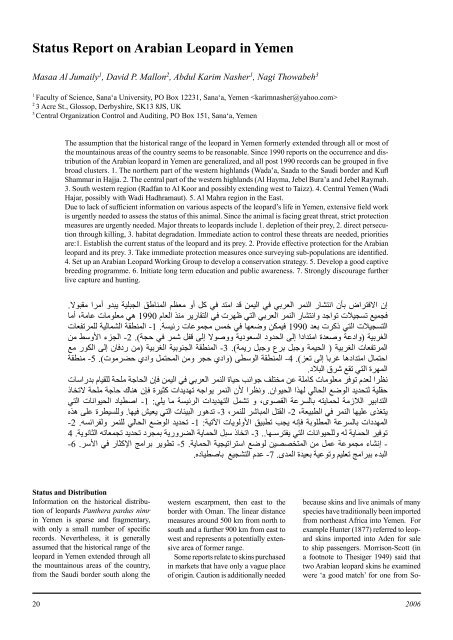Status and Conservation of the Leopard on the Arabian Peninsula ...
Status and Conservation of the Leopard on the Arabian Peninsula ...
Status and Conservation of the Leopard on the Arabian Peninsula ...
Create successful ePaper yourself
Turn your PDF publications into a flip-book with our unique Google optimized e-Paper software.
<str<strong>on</strong>g>Status</str<strong>on</strong>g> Report <strong>on</strong> <strong>Arabian</strong> <str<strong>on</strong>g>Leopard</str<strong>on</strong>g> in Yemen<br />
Masaa Al Jumaily 1 , David P. Mall<strong>on</strong> 2 , Abdul Karim Nasher 1 , Nagi Thowabeh 3<br />
1 Faculty <str<strong>on</strong>g>of</str<strong>on</strong>g> Science, Sana‘a University, PO Box 12231, Sana‘a, Yemen <br />
2 3 Acre St., Glossop, Derbyshire, SK13 8JS, UK<br />
3 Central Organizati<strong>on</strong> C<strong>on</strong>trol <str<strong>on</strong>g>and</str<strong>on</strong>g> Auditing, PO Box 151, Sana‘a, Yemen<br />
The assumpti<strong>on</strong> that <str<strong>on</strong>g>the</str<strong>on</strong>g> historical range <str<strong>on</strong>g>of</str<strong>on</strong>g> <str<strong>on</strong>g>the</str<strong>on</strong>g> leopard in Yemen formerly extended through all or most <str<strong>on</strong>g>of</str<strong>on</strong>g><br />
<str<strong>on</strong>g>the</str<strong>on</strong>g> mountainous areas <str<strong>on</strong>g>of</str<strong>on</strong>g> <str<strong>on</strong>g>the</str<strong>on</strong>g> country seems to be reas<strong>on</strong>able. Since 1990 reports <strong>on</strong> <str<strong>on</strong>g>the</str<strong>on</strong>g> occurrence <str<strong>on</strong>g>and</str<strong>on</strong>g> distributi<strong>on</strong><br />
<str<strong>on</strong>g>of</str<strong>on</strong>g> <str<strong>on</strong>g>the</str<strong>on</strong>g> <strong>Arabian</strong> leopard in Yemen are generalized, <str<strong>on</strong>g>and</str<strong>on</strong>g> all post 1990 records can be grouped in five<br />
broad clusters. 1. The nor<str<strong>on</strong>g>the</str<strong>on</strong>g>rn part <str<strong>on</strong>g>of</str<strong>on</strong>g> <str<strong>on</strong>g>the</str<strong>on</strong>g> western highl<str<strong>on</strong>g>and</str<strong>on</strong>g>s (Wada’a, Saada to <str<strong>on</strong>g>the</str<strong>on</strong>g> Saudi border <str<strong>on</strong>g>and</str<strong>on</strong>g> Kufl<br />
Shammar in Hajja. 2. The central part <str<strong>on</strong>g>of</str<strong>on</strong>g> <str<strong>on</strong>g>the</str<strong>on</strong>g> western highl<str<strong>on</strong>g>and</str<strong>on</strong>g>s (Al Hayma, Jebel Bura’a <str<strong>on</strong>g>and</str<strong>on</strong>g> Jebel Raymah.<br />
3. South western regi<strong>on</strong> (Radfan to Al Koor <str<strong>on</strong>g>and</str<strong>on</strong>g> possibly extending west to Taizz). 4. Central Yemen (Wadi<br />
Hajar, possibly with Wadi Hadhramaut). 5. Al Mahra regi<strong>on</strong> in <str<strong>on</strong>g>the</str<strong>on</strong>g> East.<br />
Due to lack <str<strong>on</strong>g>of</str<strong>on</strong>g> sufficient informati<strong>on</strong> <strong>on</strong> various aspects <str<strong>on</strong>g>of</str<strong>on</strong>g> <str<strong>on</strong>g>the</str<strong>on</strong>g> leopard’s life in Yemen, extensive field work<br />
is urgently needed to assess <str<strong>on</strong>g>the</str<strong>on</strong>g> status <str<strong>on</strong>g>of</str<strong>on</strong>g> this animal. Since <str<strong>on</strong>g>the</str<strong>on</strong>g> animal is facing great threat, strict protecti<strong>on</strong><br />
measures are urgently needed. Major threats to leopards include 1. depleti<strong>on</strong> <str<strong>on</strong>g>of</str<strong>on</strong>g> <str<strong>on</strong>g>the</str<strong>on</strong>g>ir prey, 2. direct persecuti<strong>on</strong><br />
through killing, 3. habitat degradati<strong>on</strong>. Immediate acti<strong>on</strong> to c<strong>on</strong>trol <str<strong>on</strong>g>the</str<strong>on</strong>g>se threats are needed, priorities<br />
are:1. Establish <str<strong>on</strong>g>the</str<strong>on</strong>g> current status <str<strong>on</strong>g>of</str<strong>on</strong>g> <str<strong>on</strong>g>the</str<strong>on</strong>g> leopard <str<strong>on</strong>g>and</str<strong>on</strong>g> its prey. 2. Provide effective protecti<strong>on</strong> for <str<strong>on</strong>g>the</str<strong>on</strong>g> <strong>Arabian</strong><br />
leopard <str<strong>on</strong>g>and</str<strong>on</strong>g> its prey. 3. Take immediate protecti<strong>on</strong> measures <strong>on</strong>ce surveying sub-populati<strong>on</strong>s are identified.<br />
4. Set up an <strong>Arabian</strong> <str<strong>on</strong>g>Leopard</str<strong>on</strong>g> Working Group to develop a c<strong>on</strong>servati<strong>on</strong> strategy. 5. Develop a good captive<br />
breeding programme. 6. Initiate l<strong>on</strong>g term educati<strong>on</strong> <str<strong>on</strong>g>and</str<strong>on</strong>g> public awareness. 7. Str<strong>on</strong>gly discourage fur<str<strong>on</strong>g>the</str<strong>on</strong>g>r<br />
live capture <str<strong>on</strong>g>and</str<strong>on</strong>g> hunting.<br />
. ﻻﻮﺒﻘﻣ اﺮﻣأ وﺪﺒﯾ ﺔﯿﻠﺒﺠﻟا ﻖﻃﺎﻨﻤﻟا ﻢﻈﻌﻣ وأ ﻞﻛ ﻲﻓ ﺪﺘﻣا ﺪﻗ ﻦﻤﯿﻟا ﻲﻓ ﻲﺑﺮﻌﻟا ﺮﻤﻨﻟا رﺎﺸﺘﻧا نﺄﺑ ضاﺮﺘﻓﻻا نإ<br />
ﺎﻣأ ،ﺔﻣﺎﻋ تﺎﻣﻮﻠﻌﻣ ﻲھ 1990 مﺎﻌﻟا ﺬﻨﻣ ﺮﯾرﺎﻘﺘﻟا ﻲﻓ تﺮﮭﻇ ﻲﺘﻟا ﻲﺑﺮﻌﻟا ﺮﻤﻨﻟا رﺎﺸﺘﻧاو ﺪﺟاﻮﺗ تﻼﯿﺠﺴﺗ ﻊﯿﻤﺠﻓ<br />
تﺎﻌﻔﺗﺮﻤﻠﻟ ﺔﯿﻟﺎﻤﺸﻟا ﺔﻘﻄﻨﻤﻟا -1<br />
. ﺔﺴﯿﺋر تﺎﻋﻮﻤﺠﻣ<br />
ﺲﻤﺧ ﻲﻓ ﺎﮭﻌﺿو ﻦﻜﻤﯿﻓ 1990 ﺪﻌﺑ تﺮﻛذ ﻲﺘﻟا تﻼﯿﺠﺴﺘﻟا<br />
ﻦﻣ ﻂﺳوﻷا ءﺰﺠﻟا -2<br />
.( ﺔﺠﺣ ﻲﻓ ﺮﻤﺷ ﻞﻔﻗ ﻰﻟإ ﻻﻮﺻوو ﺔﯾدﻮﻌﺴﻟا دوﺪﺤﻟا ﻰﻟإ اداﺪﺘﻣا ةﺪﻌﺻو ﺔﻋداو)<br />
ﺔﯿﺑﺮﻐﻟا<br />
ﻊﻣ رﻮﻜﻟا ﻰﻟإ نﺎﻓدر ﻦﻣ)<br />
ﺔﯿﺑﺮﻐﻟا ﺔﯿﺑﻮﻨﺠﻟا ﺔﻘﻄﻨﻤﻟا -3<br />
.( ﺔﻤﯾر ﻞﺒﺟو عﺮﺑ ﻞﺒﺟو ﺔﻤﯿﺤﻟا ) ﺔﯿﺑﺮﻐﻟا تﺎﻌﻔﺗﺮﻤﻟا<br />
ﺔﻘﻄﻨﻣ -5<br />
.( تﻮﻣﺮﻀﺣ يداو ﻞﻤﺘﺤﻤﻟا ﻦﻣو ﺮﺠﺣ يداو)<br />
ﻰﻄﺳﻮﻟا ﺔﻘﻄﻨﻤﻟا -4<br />
.( ﺰﻌﺗ ﻰﻟإ ﺎﺑﺮﻏ ﺎھداﺪﺘﻣا لﺎﻤﺘﺣا<br />
. دﻼﺒﻟا قﺮﺷ ﻊﻘﺗ ﻲﺘﻟا ةﺮﮭﻤﻟا<br />
تﺎﺳارﺪﺑ مﺎﯿﻘﻠﻟ ﺔﺤﻠﻣ ﺔﺟﺎﺤﻟا نﺈﻓ ﻦﻤﯿﻟا ﻲﻓ ﻲﺑﺮﻌﻟا ﺮﻤﻨﻟا ةﺎﯿﺣ ﺐﻧاﻮﺟ ﻒﻠﺘﺨﻣ ﻦﻋ ﺔﻠﻣﺎﻛ تﺎﻣﻮﻠﻌﻣ ﺮﻓﻮﺗ مﺪﻌﻟ اﺮﻈﻧ<br />
ذﺎﺨﺗﻻ ﺔﺤﻠﻣ ﺔﺟﺎﺣ كﺎﻨھ نﺈﻓ ةﺮﯿﺜﻛ تاﺪﯾﺪﮭﺗ ﮫﺟاﻮﯾ ﺮﻤﻨﻟا نﻷ اﺮﻈﻧو . ناﻮﯿﺤﻟا اﺬﮭﻟ ﻲﻟﺎﺤﻟا ﻊﺿﻮﻟا ﺪﯾﺪﺤﺘﻟ ﺔﯿﻠﻘﺣ<br />
ﻲﺘﻟا تﺎﻧاﻮﯿﺤﻟا دﺎﯿﻄﺻا -1<br />
: ﻲﻠﯾ ﺎﻣ ﺔﺴﯿﺋﺮﻟا تاﺪﯾﺪﮭﺘﻟا ﻞﻤﺸﺗ و ،ىﻮﺼﻘﻟا ﺔﻋﺮﺴﻟﺎﺑ ﮫﺘﯾﺎﻤﺤﻟ ﺔﻣزﻼﻟا ﺮﯿﺑاﺪﺘﻟا<br />
هﺬھ ﻰﻠﻋ ةﺮﻄﯿﺴﻠﻟو . ﺎﮭﯿﻓ ﺶﯿﻌﯾ ﻲﺘﻟا تﺎﺌﯿﺒﻟا رﻮھﺪﺗ -3<br />
،ﺮﻤﻨﻠﻟ ﺮﺷﺎﺒﻤﻟا ﻞﺘﻘﻟا -2<br />
،ﺔﻌﯿﺒﻄﻟا ﻲﻓ ﺮﻤﻨﻟا ﺎﮭﯿﻠﻋ ىﺬﻐﺘﯾ<br />
-2<br />
. ﮫﺴﺋاﺮﻔﻟو ﺮﻤﻨﻠﻟ ﻲﻟﺎﺤﻟا ﻊﺿﻮﻟا ﺪﯾﺪﺤﺗ -1<br />
: ﺔﯿﺗﻵا تﺎﯾﻮﻟوﻷا ﻖﯿﺒﻄﺗ ﺐﺠﯾ ﮫﻧﺈﻓ ﺔﺑﻮﻠﻄﻤﻟا ﺔﻋﺮﺴﻟﺎﺑ تادﺪﮭﻤﻟا<br />
4 . ﺔﯾﻮﻧﺎﺜﻟا ﮫﺗﺎﻌﻤﺠﺗ ﺪﯾﺪﺤﺗ دﺮﺠﻤﺑ ﺔﯾروﺮﻀﻟا ﺔﯾﺎﻤﺤﻟا ﻞﺒﺳ ذﺎﺨﺗا -3<br />
.. ﺎﮭـﺳﺮﺘﻔﯾ ﻲﺘﻟا تﺎﻧاﻮﯿﺤﻠﻟو ﮫﻟ ﺔﯾﺎﻤﺤﻟا ﺮﯿﻓﻮﺗ<br />
-6<br />
. ﺮﺳﻷا ﻲﻓ رﺎﺜﻛﻹا ﺞﻣاﺮﺑ ﺮﯾﻮﻄﺗ -5<br />
. ﺔﯾﺎﻤﺤﻟا<br />
ﺔﯿﺠﯿﺗاﺮﺘﺳا ﻊﺿﻮﻟ ﻦﯿﺼﺼﺨﺘﻤﻟا ﻦﻣ ﻞﻤﻋ ﺔﻋﻮﻤﺠﻣ ءﺎﺸﻧإ -<br />
.<br />
هدﺎﯿﻄﺻﺎﺑ ﻊﯿﺠﺸﺘﻟا مﺪﻋ -7<br />
. ىﺪﻤﻟا ةﺪﯿﻌﺑ ﺔﯿﻋﻮﺗو ﻢﯿﻠﻌﺗ ﺞﻣاﺮﺒﺑ ءﺪﺒﻟا<br />
<str<strong>on</strong>g>Status</str<strong>on</strong>g> <str<strong>on</strong>g>and</str<strong>on</strong>g> Distributi<strong>on</strong><br />
Informati<strong>on</strong> <strong>on</strong> <str<strong>on</strong>g>the</str<strong>on</strong>g> historical distributi<strong>on</strong><br />
<str<strong>on</strong>g>of</str<strong>on</strong>g> leopards Pan<str<strong>on</strong>g>the</str<strong>on</strong>g>ra pardus nimr<br />
in Yemen is sparse <str<strong>on</strong>g>and</str<strong>on</strong>g> fragmentary,<br />
with <strong>on</strong>ly a small number <str<strong>on</strong>g>of</str<strong>on</strong>g> specific<br />
records. Never<str<strong>on</strong>g>the</str<strong>on</strong>g>less, it is generally<br />
assumed that <str<strong>on</strong>g>the</str<strong>on</strong>g> historical range <str<strong>on</strong>g>of</str<strong>on</strong>g> <str<strong>on</strong>g>the</str<strong>on</strong>g><br />
leopard in Yemen extended through all<br />
<str<strong>on</strong>g>the</str<strong>on</strong>g> mountainous areas <str<strong>on</strong>g>of</str<strong>on</strong>g> <str<strong>on</strong>g>the</str<strong>on</strong>g> country,<br />
from <str<strong>on</strong>g>the</str<strong>on</strong>g> Saudi border south al<strong>on</strong>g <str<strong>on</strong>g>the</str<strong>on</strong>g><br />
western escarpment, <str<strong>on</strong>g>the</str<strong>on</strong>g>n east to <str<strong>on</strong>g>the</str<strong>on</strong>g><br />
border with Oman. The linear distance<br />
measures around 500 km from north to<br />
south <str<strong>on</strong>g>and</str<strong>on</strong>g> a fur<str<strong>on</strong>g>the</str<strong>on</strong>g>r 900 km from east to<br />
west <str<strong>on</strong>g>and</str<strong>on</strong>g> represents a potentially extensive<br />
area <str<strong>on</strong>g>of</str<strong>on</strong>g> former range.<br />
Some reports relate to skins purchased<br />
in markets that have <strong>on</strong>ly a vague place<br />
<str<strong>on</strong>g>of</str<strong>on</strong>g> origin. Cauti<strong>on</strong> is additi<strong>on</strong>ally needed<br />
because skins <str<strong>on</strong>g>and</str<strong>on</strong>g> live animals <str<strong>on</strong>g>of</str<strong>on</strong>g> many<br />
species have traditi<strong>on</strong>ally been imported<br />
from nor<str<strong>on</strong>g>the</str<strong>on</strong>g>ast Africa into Yemen. For<br />
example Hunter (1877) referred to leopard<br />
skins imported into Aden for sale<br />
to ship passengers. Morris<strong>on</strong>-Scott (in<br />
a footnote to Thesiger 1949) said that<br />
two <strong>Arabian</strong> leopard skins he examined<br />
were ‘a good match’ for <strong>on</strong>e from So-<br />
20 2006


